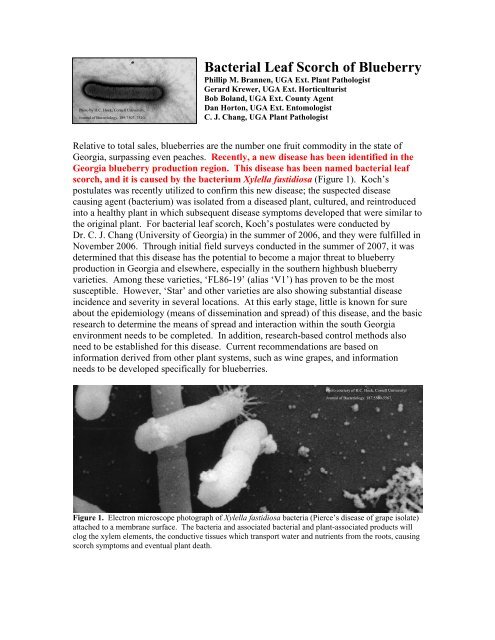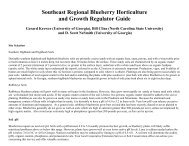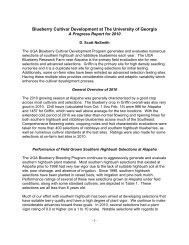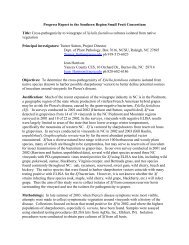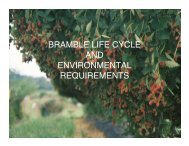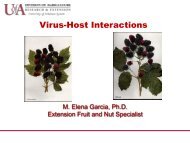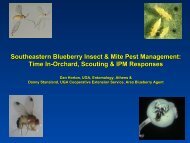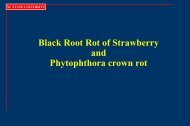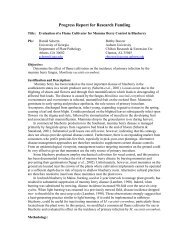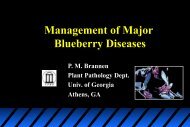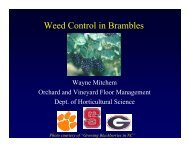Bacterial Leaf Scorch of Blueberry - The Southern Region Small ...
Bacterial Leaf Scorch of Blueberry - The Southern Region Small ...
Bacterial Leaf Scorch of Blueberry - The Southern Region Small ...
You also want an ePaper? Increase the reach of your titles
YUMPU automatically turns print PDFs into web optimized ePapers that Google loves.
Causal organism. <strong>The</strong> Xylella fastidiosa bacterium is pathogenic on numerous plantspecies. In addition, it is known to inhabit many host plants without causing diseasesymptoms; among these are various grasses and herbaceous weeds which are generallyfound throughout the blueberry production region <strong>of</strong> Georgia; native blueberries alsolikely harbor the bacterium. <strong>The</strong>refore, there is generally a bacterial reservoir which isreadily available for infection.Little is known about the specific Xylella fastidiosa strain found in blueberry. Thisbacterium may be genetically identical to the subspecies causing Pierce’s disease <strong>of</strong> grapeor the one causing phony peach, major Xyllella-incited diseases which also occur inGeorgia, or it may distinct from both. As in other Xylella-incited diseases, it is assumedthat the bacterium blocks xylem vessels, thereby preventing water and nutrient flow fromthe soil throughout the plant. This bacterium only survives in plant xylem or within theinsects which vector it. In general, Xylella diseases are more prevalent in warmerenvironments; this is related in part to the fact that the insect vectors, primarilysharpshooters, survive better in warmer environments, but the bacterium also overwintersmore successfully within host plants in warmer climates. Though it is speculation at thispoint, the increase in bacterial leaf scorch in Georgia may be at least partially related towarmer winters which may have aided survival <strong>of</strong> vectors and the bacterium. Withoutregard, South Georgia and Florida provide ideal environments for both the bacterium andthe vectors to survive.To date, the disease has been an obviously observed field problem <strong>of</strong> southern highbushblueberry varieties only. It is not known whether this disease is also causing problems inrabbiteye varieties. <strong>The</strong> bacterium can in fact colonize rabbiteye plants, but whether ornot it results in chronic or acute disease has not been determined for rabbiteye varieties.However, there is no doubt at this point that the disease is causing chronic and acutelosses in southern highbush varieties.Disease cycle and causal conditions. <strong>The</strong> disease cycle <strong>of</strong> this bacterium in grape,peach, and plum is well known, and it is likely the same in blueberry. Infected hostsserve as reservoirs and overwintering sites <strong>of</strong> the bacterium. In the spring and earlysummer, insect vectors, sharpshooters and spittle bugs, transmit the bacterium throughfeeding on infected plant tissues and subsequent feeding on healthy plants. In othersystems, the glassy-winged sharpshooter, Homalodisca coagulata, is the most importantvector. <strong>The</strong> glassy-winged sharpshooter can be found abundantly in south Georgia andFlorida, where it is known to be the major vector <strong>of</strong> Xylella in peach, while alsopreventing production <strong>of</strong> European wine grapes. Once the insect has acquired thebacterium, it is transmitted to a new plant as the insect injects the bacterium into thexylem (the conductive tissues which transmit water and nutrients from the roots to theother plant tissues) during feeding. This bacterial species is unique in that it is limited tolife in the plant xylem. Movement <strong>of</strong> the bacterium occurs throughout the plant xylemsystem. At some point, bacteria form colonies, and through a combination <strong>of</strong> tyloses,gumming and bacterial exudate production, the xylem is clogged. In time, clogging <strong>of</strong>vessels reaches a point at which individual stems or whole plants will no longer be able to
carry sufficient water and nutrients to support life. At this point symptoms develop, andeventually the plant will die. Plant death can be relatively rapid, but in general, symptomdevelopment starts in one year and continues through at least a second season beforeplant death.Though it has not been proven, it is assumed that this bacterium can be transmittedthrough propagation from infected plants. If so, then this is particularly troubling, sincemassive numbers <strong>of</strong> plants can be disseminated rapidly to expand the epidemic. <strong>The</strong>combination <strong>of</strong> propagation and insect vectoring could cause rapid spread throughout theentire region. However, it is likely that infected plants would not be utilized forpropagation very <strong>of</strong>ten, since they would show disease symptoms. In addition,propagated, infected plants may be killed rapidly in the nursery, therefore preventingadditional spread. This raises many questions and much research is needed to address thespecific question <strong>of</strong> propagative spread through cuttings.Root grafting may also serve as a potential transmission mechanism. In high-densitybeds, this may be particularly important as a means <strong>of</strong> spread, but again, there has beenno research conducted to date to support this premise.Symptoms. <strong>The</strong> initial symptom is a marginal leaf scorch (burn), which unfortunately issimilar to that observed with extreme drought, fertilizer salt burn, or root rots (Figure2). Sometimes, the scorched leaf area is bordered by a darker band between the healthyand scorched tissue. This leaf symptom can be uniformly distributed throughout the plant,but in the early stages, scorching may be limited to individual stems or perhaps one side<strong>of</strong> the plant – indicating that only a partial xylem blockage has occurred which may belimited to one cane or one stem. Spring growth is characterized by twigs <strong>of</strong> very thindiameter. Eventually, leaves abscise (drop), and young twigs/stems may take on a yellowappearance (Figures 3-4). After leaf drop, the plant eventually dies (Figure 5). Often,where a plant has died from bacterial leaf scorch, a neighboring plant will showsymptoms the following year.<strong>The</strong> most unique symptom <strong>of</strong> bacterial leaf scorch is actually observed once leaves havedropped – the yellowed stems and twigs. <strong>The</strong> plant can drop virtually all leaves and yetremain otherwise healthy in appearance; the stems and root systems appear sound, andvascular discoloration is not generally observed. Once the leaves have dropped from theplant, the plant takes on a skeleton-like appearance. Dieback is also not generallyassociated with this disease in the early stages; <strong>of</strong> course, the final result is plant death,and at that point it is not possible to diagnose the cause <strong>of</strong> death.
Figure 4. Panoramic view <strong>of</strong> an individual plant with bacterial scorch symptoms. Some surroundingplants are also starting to show early symptoms as well.Figure 5. Plants which have died from bacterial leaf scorch. At this stage, it would be very difficult todetermine that bacterial leaf scorch was the cause <strong>of</strong> death, especially once plants have been hedged.Symptoms are virtually identical to those <strong>of</strong> root rot, but in this case, there is no excessive moisture or lowareas which would be <strong>of</strong>ten associated with root rot. Also, the pattern <strong>of</strong> spread is different from root rot,in that scattered dead plants are observed; root rot mortality is <strong>of</strong>ten clumped, especially around low, wetareas.<strong>The</strong> bacterium cannot be easily observed with a light microscope, so confirmation is onlypossible through ELISA or PCR techniques in a lab. In addition, observation <strong>of</strong> bacterialgrowth on specialized media is also recommended for confirmation <strong>of</strong> this disease.Cultural controls. (1). It is essential that new plants not be propagated from Xylellainfected plants. At this point, there is no testing program for propagation. However,propagators should never take cuttings from plants which they have not personallyinspected for visual disease symptoms. Diseased plants should never be utilized forpropagation, whether they have symptoms <strong>of</strong> Xylella or viruses or other diseases <strong>of</strong>blueberry.(2). Identification <strong>of</strong> Xylella-infected plants is possible in the field, and once such plantsare identified, they should be flagged and immediately destroyed. By doing this, it ishoped that the epidemic will be slowed.
(3). <strong>The</strong>re may also be a tie-in between plant stress and successful infection by Xylella;therefore, reduction <strong>of</strong> plant stresses, such as drought stress, may at least slow symptomdevelopment, if not preventing it altogether.(4). We have observed potential varietal field resistance in some southern highbushblueberries, but this has not been confirmed scientifically. <strong>The</strong> ‘FL86-19’ variety isparticularly susceptible to infection and disease development by Xylella. Whencompared with other southern highbush or rabbiteye varieties, the ‘FL86-19’ varietyquickly develops symptoms and high bacterial titers after manual inoculations, whichcorrelates well with observed susceptibility in the field. On the other hand, ‘V5’ has beenobserved to have presumed field resistance to this bacterium (Figure 6). Though thispresumed resistance needs to be confirmed through further research, this is encouraging,since it likely indicates that breeding can be utilized to develop varieties which are highlyresistant to Xylella.Figure 6. Potential resistance. In this planting, a single row <strong>of</strong> ‘V5’ plants was alternately planted after 10rows <strong>of</strong> ‘FL86-19’ plants (repeated numerous times). <strong>The</strong> surrounding ‘FL86-19’ plants were all infected,with significant mortality, and they have been removed at this point; the ‘V5’ plants consistently show nosymptoms <strong>of</strong> disease or mortality after five years at this site. From this anecdotal information, it is notpossible to determine conclusively that this is resistance, but it is encouraging, and it very likely indicatesfield resistance in the ‘V5’ line.
Chemical controls. At this point, there are no chemical controls which actively kill thebacterium. However, it may be possible to slow or even break the disease cycle by vectormanagement, killing the insects which transmit the bacterium. <strong>The</strong>re are in fact severalinsecticides which are active against leafhoppers, and several <strong>of</strong> these are registered foruse on blueberries.(1). Application <strong>of</strong> soil-applied neonicotinoid products (imidacloprid or thiamethoxam)should take place as plants begin their initial spring flush. With any <strong>of</strong> the neonicotinoidmaterials, their systemic qualities will be best observed when there is good moisture andactive growth. In parallel fashion, neonicotinoid longevity is much better with soilapplication than with foliar application. Product longevity and performance,extrapolating from ornamentals, are influenced by rate, hence applying the highestlabeled rate is best. For blueberries, the neonicotinoids labeled for soil applicationinclude imidacloprid products (Admire 2F, Admire Pro, Advise 2FL, Alias 2F, Courage2F, Imida E-AG 2F, Nuprid 2F) and a thiamethoxam product (Platinum 2EC).(2). During the late spring period, which may correlate with the period <strong>of</strong> actual vectoringby sharpshooters, foliar-applied pyrethroids and organophosphates should be utilized toaugment or complement the neonicotinoid drench, especially if glassy-wingedsharpshooters are observed in sticky traps.As mentioned throughout this fact sheet, additional research will be needed to address thebasic questions we have relative to this new menace to the blueberry industry. However,it is likely that this disease will mimic similar diseases in other plant systems. As such,we can extrapolate the need for a management program, to include cultural and chemicalcontrol and breeding programs. <strong>Southern</strong> highbush blueberry producers should activelyincorporate suggested management practices for this disease, as they have others.Otherwise, the epidemic will likely increase throughout the region, resulting in majorlosses.Contact your local county agent for additional information or specific chemicalrecommendations.
References.C.J. Chang, P.M. Brannen, G. Krewer, B. Boland, and R. Donaldson. 2007. <strong>Bacterial</strong> leafscorch <strong>of</strong> blueberry: a new disease caused by Xylella fastidiosa (Abstr.). Phytopathology97(7):S20.M.M. Meyer, B.C. Kirkpatrick. 2007. Effects <strong>of</strong> cold temperatures and variety on coldcuring <strong>of</strong> Xylella fastidiosa infected grapevines (Abstr.). Phytopathology 97(7):S76.L. Varela, R.J. Smith, and P.A. Phillips. 2001. Pierce’s Disease. University <strong>of</strong> CaliforniaAgricultural and Natural Resources Pub. 21600.J.M. Wells. 1995. Phony Peach. Pages 53-54 in: Compendium <strong>of</strong> Stone Fruit Diseases.J.M. Ogawa, E.I. Zehr, G.W. Bird, D.F. Ritchie, K. Uriu, and J.K. Uyemoto, eds. APSPress, St. Paul, MN.An Equal Opportunity Employer/Affirmative Action OrganizationCommitted to a Diverse Work Force


